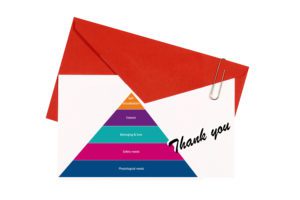
How can a simple gesture give work more purpose?
How can a simple gesture give work more purpose? 1. Send a note: This past
When I first studied counseling skills, the course ended with our group of students and teachers going on a weekend retreat. While there we each had to create and share our personal coat of arms. Each was topped with a single word to represent our deepest value or belief. My word was COURAGE.
I’m no warrior: I’m a theatre artist, not a martial artist! But I choose to be a risk taker, an avid pursuer of opportunity, and a believer that things in this world, and in our relationships, can be changed for the better. Like most adults I’ve been burned a few times, but I believe that we can rise like a phoenix from the ashes of setback, failure, embarrassment and pain.
When I think of courage, I think of this quote from Franklin D. Roosevelt:
“Courage is not the absence of fear, but rather the assessment that something else is more important than fear.”
― Franklin D. Roosevelt
When do you feel afraid, anxious, nervous, full of worry or doubt?
For me, it tends to show up just before I enter a situation for the first time, when I’m not sure what to expect. On reflection, that’s a lifelong pattern; I was often the ‘new kid’ at school. These days, I frequently find myself about to coach executives from unfamiliar industries. I feel it also when I’m standing outside a networking event and there are no familiar faces around. And, despite being passionate and excited about performing, it even shows up just before I step on to a stage to deliver a new presentation or for the opening night of a play.
I’m a high extrovert, a veteran coach, a seasoned performer, yet pinballing around inside my head I still hear questions like: “What if it goes wrong?”, “What if I can’t?”, “What if they don’t like me?”, “What if I look foolish?”.
What helps me get past those voices? How do I summon up courage? How do you?
“Courage is a heart word. The root of the word courage is cor – the Latin word for heart. In one of its earliest forms, the word courage meant “To speak one’s mind by telling all one’s heart”… Speaking from our hearts is what I think of as ‘ordinary courage’.”
― Brené Brown
“I Thought It Was Just Me”
If you struggle to acknowledge fear, it may help to try out ‘socially acceptable synonyms’: “I feel a little anxious about…”, “I could really use your help around…”, “Your support on… would be welcome”, “I’m conscious I feel worried worried about…”, “May I share some concerns I feel about…?”.
I see courage as a decision, a choice, an exercise of free will. We elect to bring our courage into the arena with us, rather than running away from the arena. We choose to be courageous afterweighing thoughts, feelings, odds and outcomes, and knowing there is risk involved. When we recognise our fear, we exercise courage to empower us to some deliberate act – doing or saying something… Or we may need courage to enable an act of self-control so we purposely do or say nothing. But courage is never present in indecision, timidity or passivity.
What is important enough to push you beyond your boundary of fear? How do you summon courage. Does courage need to show up more in your professional life? What conversations are you avoiding due to fear or anxiety?
Dramatic Difference and how we work with courage
My colleagues and I have recently refined and begun working with our own Dramatic Difference model for High Performance Dialogue (our “C4 High Performance Dialogue Model”). Courage is the third C in that model. Our C4 Model is supported by practical, experiential learning toolkits inspired by our work with and study of researchers and thought leaders such as George Kohlrieser, Judith E. Glaser, Viola Spolin, Daniel Kahneman, Daniel Goleman, Amy Cuddy, Angela Duckworth, Martin Seligmann, David Rock and others.
We’ve tested the tools, techniques, materials and methods with thousands of executives over the past 25 years and we love them. They work! They help us distil courage and use it in the laboratory of real life.
Yes, C4 is explosive: it can blow up a mountain, or be used in an amount so tiny that it just blows the lock out of a closed door. It is pliable and moulds to any shape. To us, C4 represents disruptive, creative conversations.
C4 is also a protein crucial to tolerance and antibodies in the immune system. So to us, in dialogue, it represents psychological safety, inclusion, and crucial conversations.
And C4 is a vertebra in the human spine that is crucial to our movement in all directions – forwards, backwards and sideways. It is also vitally important in our breathing mechanism. To us it represents both presence and agility in dialogue.
If you’re intrigued by our C4 Model and how it can help you access and build your courage, and dialogue skills, please ask us, we’d love to talk to you! (And there are 3 more Cs to explore…)
We welcome your stories of courage, and your comments on this blog.
“Always remember you are braver than you believe, stronger than you seem, and smarter than you think.”
“Christopher Robin” — A.A. Milne

How can a simple gesture give work more purpose? 1. Send a note: This past


Which Witch Will YOU Stop Ducking? Last week I saw a wonderful post on Facebook


(…or how to stop hating your co-workers) Sometimes it happens like this: you’re merrily going